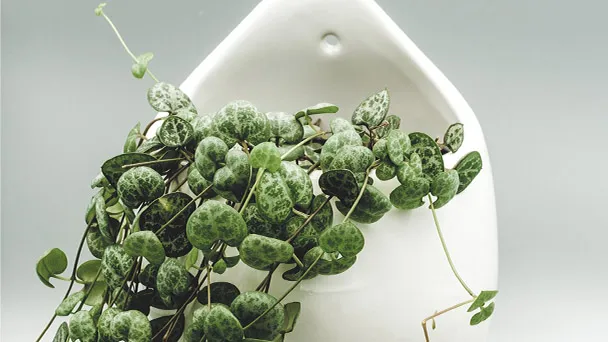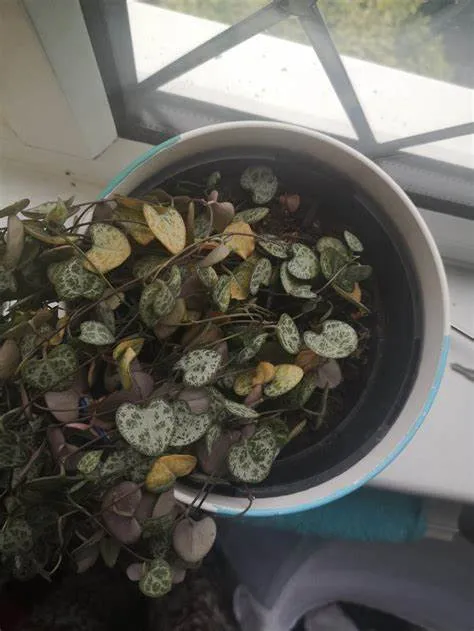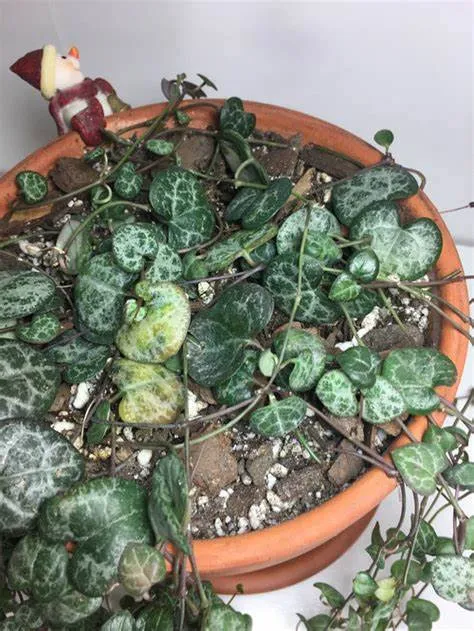Why My String of Hearts Have Yellow Leaves
Written by Ivy
Jan 20 2023

If your string of hearts have yellow leaves, it may because of overwatering, drainage issues and low temperatures. Let's learn how to solve it!
Read More: How to Save Overwatered String of Hearts

Read More:
OverwateringAvoid harsh sunlightMaintain temperatureReasonable wateringPicking up your String of Hearts Plant to propagateDrainage issuesAdd perlite into the potting mix Ensure your pot has drainage holes Use clay/terracotta pots Low temperaturesHow to properly water a String of Hearts1. Check the dry and wet condition of basin soil2. Check the weight of the flowerpot3. Inspection through drain hole4. Growth state of branches and leavesCan you Save it by Propagating a Healthier Part?
Overwatering
One of the main reasons why the leaves of string of hearts turn yellow is that they are watered too frequently. Once the basin soil has too much water, the leaves of string of hearts will turn yellow and wilt, and eventually the roots and tubers will rot.Read More: How to Save Overwatered String of Hearts

Avoid harsh sunlight
String of hearts plant likes to grow in a scattering environment, so we should avoid exposing string of hearts to the sun during maintenance, especially in summer. If we put string of hearts in the sun, its leaves will be sunburned, resulting in yellow leaves. If we accidentally sunburn, Timely transfer the string of hearts to a cool and ventilated environment.Maintain temperature
String of hearts likes a warm growth environment. During the maintenance period, it is necessary to keep the temperature between 15 ° C and 25 ° C. string of hearts is afraid of cold, so it is best to keep the temperature above 10 ° C in winter. If the temperature is lower than 10 ° C, string of hearts will be frostbitten, resulting in yellow leaves. Therefore, the temperature in northern winter is relatively low, Keep warm in advance.Reasonable watering
The rhizome of string of hearts has a certain water storage capacity and is very drought resistant, so it does not need to be watered frequently during the maintenance period. If excessive watering causes ponding, the root of string of hearts will rot and the leaves will become yellow due to lack of nutrient transportation. Therefore, we need to wait until the soil is dry before watering during the maintenance of string of hearts.Picking up your String of Hearts Plant to propagate
For a failing String of Hearts plant, you can propagate a new plant using its healthy part. Read More String of Hearts Propagation Method Here.Drainage issues
Many people think that the most important way to care for string of hearts is to water and fertilize these later maintenance methods, but in fact, when planting string of hearts, the configuration of basin soil is also very important. Only the soil with good air permeability and nutrition can breed strong string of hearts. But how can we ensure the drainage and ventilation of string of hearts soil? In fact, we only need to pay attention to the material of the container and the ratio of soil, so as to ensure the healthy growth of roots.
Add perlite into the potting mix
In order to avoid water accumulation in string of hearts after watering, the poured water cannot flow directly from the drainage hole. After watering, there is no water at the bottom, or after raining, the basin soil is wet for several days and difficult to dry out, which means that the basin soil is too cohesive, too viscous, airtight and undrained, which can easily lead to string of hearts yellow leaves, We need to add character to improve the soil structure. When the soil in the string of hearts basin can not dry all the time, especially in autumn and winter, sometimes the temperature is relatively low, the light is not very strong, and the evaporation is very small, we can also place the string of hearts basin on the ground at a higher position.Ensure your pot has drainage holes
Potted string of hearts are basically inseparable from flowering pots. When selecting flower pots, we usually choose more appropriate flower pots according to the characteristics and size of string of hearts. For most pots, there will be holes at the bottom. Its function is to improve the drainage effect and air permeability of soil media and avoid excessive watering or blocked respiration, resulting in moldy and rotten plant roots. Therefore, we should ensure that the basin of string of hearts has drainage holes. (Also Read: How to Repot a String Of Hearts)Use clay/terracotta pots
Clay/terracotta pots has good air permeability to plant roots and better air permeability without glazing. The plants grown from string of hearts raised with clay / terracotta pots also grow faster, which can also prevent yellow leaves from appearing in string of hearts.Low temperatures
String of hearts likes a warm growth environment. During the maintenance period, it is necessary to keep the temperature between 15 ° C and 25 ° C. string of hearts is afraid of cold, so it is best to keep the temperature above 10 ° C in winter. If the temperature is lower than 10 ° C, string of hearts will be frostbitten, resulting in yellow leaves. Therefore, the temperature in northern winter is relatively low, Keep warm in advance.How to properly water a String of Hearts
1. Check the dry and wet condition of basin soil
This is extremely critical. We should check the soil every time before watering the string of hearts basin soil. Most potted plants raised indoors are usually watered after the basin soil is dry, that is to say, when the soil is dry below 3 ~ 5 cm, water it again.2. Check the weight of the flowerpot
When maintaining small potted plants in the room, we can weigh the weight of the flowerpot and test whether the soil needs water. If the weight of the flowerpot is quite different from that before watering, we can water it in time. If the weight of the flowerpot is the same as that after watering, don't rush to water it first. You can practice more times. Basically, you can pick up the string of hearts flowerpot to know whether the plant is short of water.3. Inspection through drain hole
We can take up the flowerpot and check whether the soil at the drain hole at the basin bottom has been dry. If the soil at the drain hole at the basin bottom is very dry, it must be watered in time.4. Growth state of branches and leaves
If we find that the leaves of string of hearts are yellow and curly, and we don't usually water them, it must be a lack of water. This situation will lead to the yellow leaves of string of hearts and the withered plants. We can recover better by cutting off the yellow and withered leaves and maintaining a certain air humidity.Read More:
Can you Save it by Propagating a Healthier Part?
Yes, we can save string of hearts by propagating a healthier part, and please learn more about string of hearts propagation here.Read More:
Latest Updated
- Benefits of Bugleweed - 7 Science-backed Health Benefits
- Bugleweed Dangers & Side Effects - Is It Poisonous?
- How to Plant Evergreen Trees - What You Should Know
- When to Plant Evergreens - Grow Guide for Evergreen Trees
- 12 Wonderful Evergreen Shrubs for Your Garden
- 12 Popular Evergreen Plants with Pictures for Beginners
- When And How To Prune A Lilac Bush Like a Pro
- How to Grow & Care for Lilac Vine (Hardenbergia Violacea)
- Japanese Lilac Tree (Syringa Reticulata) Care & Propagation Guide
- Shumard Oak Pros and Cons - What to Know
Popular Articles
- Winter maintenance of Antirrhinum Majus
- How to Grow Terminalia Mantaly Tree
- How to Grow and Care for Crossostephium Chinense
- How to grow Antirrhinum Majus in spring
- Peristeria Elata (Dove Orchid) Profile: Info & Care Guide
- Underwatered Snake Plant (Sansevieria Trifasciata) - Signs And How To Fix
- How to Care for Brazilian Jasmine Plant (Mandevilla Sanderi)
- How to Grow & Care for Graptopetalum Purple Delight in Summer
- Rosa Chinensis (China Rose): Plant Growing & Care Tips
- How to Care for Baby Sun Rose (Aptenia Cordifolia)